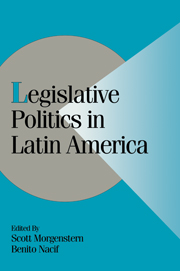Book contents
- Frontmatter
- Contents
- Tables and Figures
- Contributors
- Preface and Acknowledgments
- Party Names and Other Acronyms and Abbreviations
- 1 TOWARDS A MODEL OF LATIN AMERICAN LEGISLATURES
- Part I Executive–Legislative Relations
- Part II Political Parties and Legislative Structure
- 6 EXPLAINING THE HIGH LEVEL OF PARTY DISCIPLINE IN THE ARGENTINE CONGRESS
- 7 PARTY DISCIPLINE IN THE CHAMBER OF DEPUTIES
- 8 PARTIES, COALITIONS, AND THE CHILEAN CONGRESS IN THE 1990s
- 9 UNDERSTANDING PARTY DISCIPLINE IN THE MEXICAN CHAMBER OF DEPUTIES: THE CENTRALIZED PARTY MODEL
- Part III Legislatures and the Policy Process
- Part IV Conclusions
- References
- Author Index
- General Index
8 - PARTIES, COALITIONS, AND THE CHILEAN CONGRESS IN THE 1990s
Published online by Cambridge University Press: 14 January 2010
- Frontmatter
- Contents
- Tables and Figures
- Contributors
- Preface and Acknowledgments
- Party Names and Other Acronyms and Abbreviations
- 1 TOWARDS A MODEL OF LATIN AMERICAN LEGISLATURES
- Part I Executive–Legislative Relations
- Part II Political Parties and Legislative Structure
- 6 EXPLAINING THE HIGH LEVEL OF PARTY DISCIPLINE IN THE ARGENTINE CONGRESS
- 7 PARTY DISCIPLINE IN THE CHAMBER OF DEPUTIES
- 8 PARTIES, COALITIONS, AND THE CHILEAN CONGRESS IN THE 1990s
- 9 UNDERSTANDING PARTY DISCIPLINE IN THE MEXICAN CHAMBER OF DEPUTIES: THE CENTRALIZED PARTY MODEL
- Part III Legislatures and the Policy Process
- Part IV Conclusions
- References
- Author Index
- General Index
Summary
Chile's Congress has conventionally been regarded as among the most effective in Latin America in representing diverse interests and influencing policy. Analyses of Chilean politics prior to the 1973 coup consistently point to the strength of Chilean parties to support this evaluation. Valenzuela (1994), for example, argues for the adoption of parliamentarism in Chile largely on the grounds that its party system resembles those of western European parliamentary democracies. Mainwaring and Scully (1995) point to the stability of support for Chilean parties among the electorate, their ideological consistency, and the strength of national party organizations. In the 1990s, after the return to democracy, the central questions were whether and how the Chilean legislative party system is different from the preauthoritarian period, and what are the implications for the effectiveness of the Congress.
Accounts of Chilean politics at midcentury portray a system characterized by parties with widespread membership and activism at the grassroots, prominent parliamentary leaders, and highly articulated national policy agendas that were spread across a broad ideological spectrum (Scully 1995; Valenzuela and Wilde 1979). This portrait stands in sharp contrast to that of party systems in neighboring Argentina (McGuire 1994), Brazil (Mainwaring 1999), and Peru (Cotler 1994), where personalism and clientelism were endemic, weakening the ability of legislatures to act collectively and to compete with strong presidents in shaping policy.
In addition to portraying a highly institutionalized party system, the literature on Chilean politics emphasizes that coalitions among legislative parties were highly fluid (Agor 1971). Between 1932 and 1973, for example, Valenzuela (1994, pp. 123–125) identifies 19 separate coalitions among legislative parties in support of the eight presidents who served during this period.
- Type
- Chapter
- Information
- Legislative Politics in Latin America , pp. 222 - 253Publisher: Cambridge University PressPrint publication year: 2002
- 63
- Cited by



